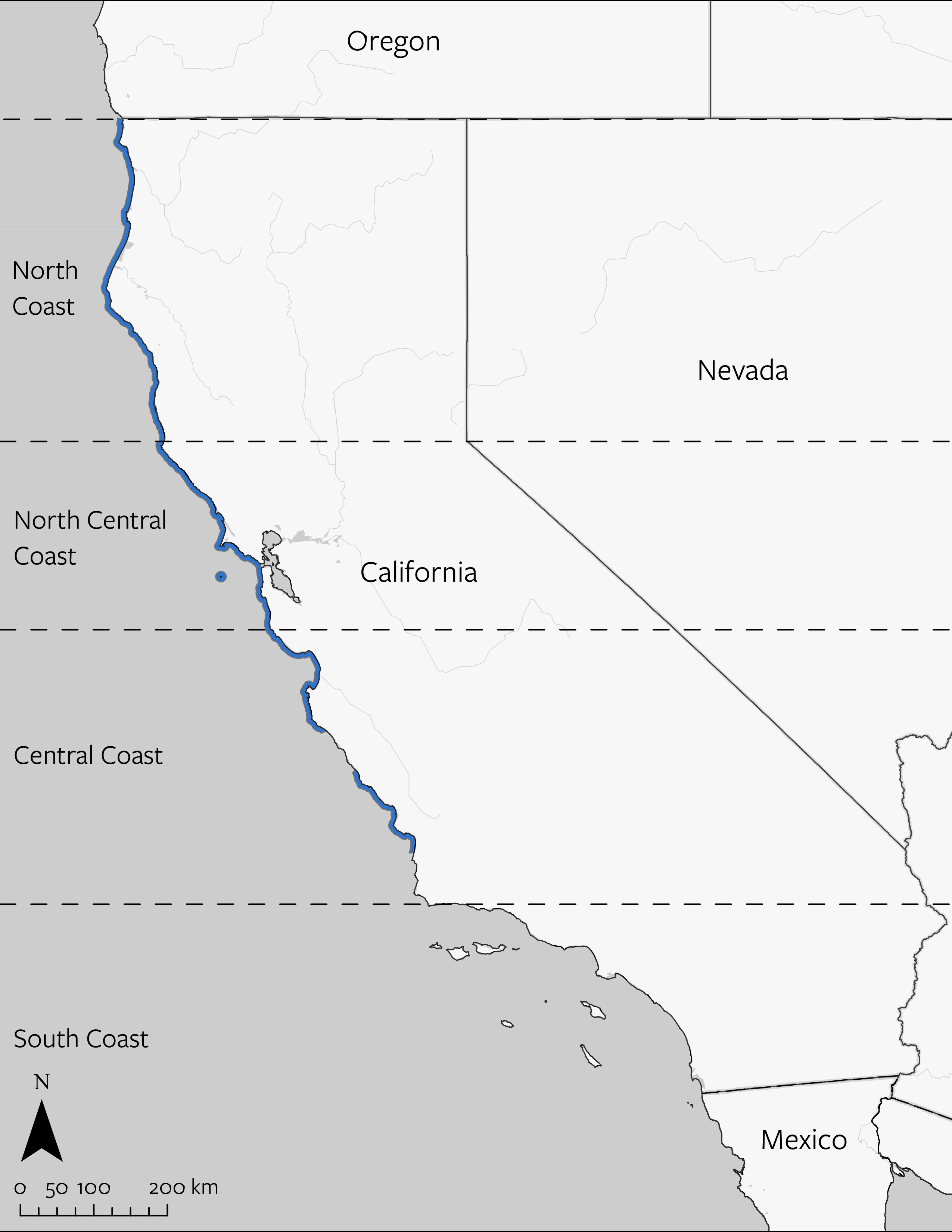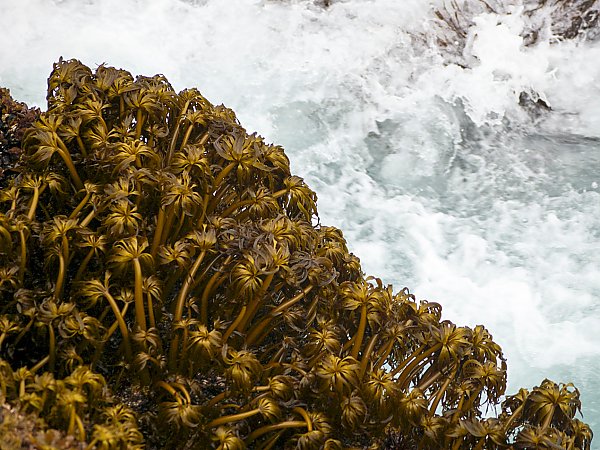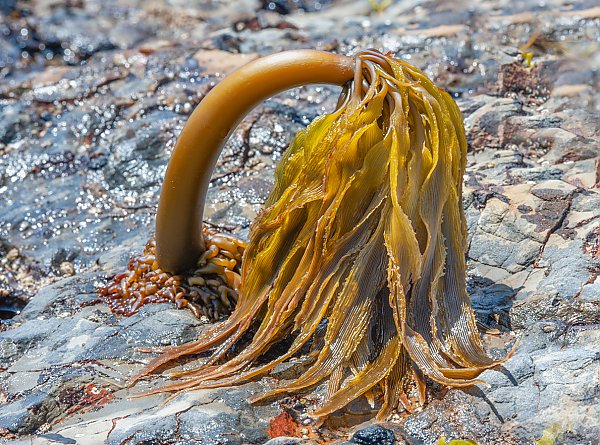Sea Palm
Postelsia palmaeformis
Sea Palm
Postelsia palmaeformis
Sea palms at index sites are showing weak declines, perhaps associated with increasing ocean temperatures.
Morphology
The sea palm, so named because it resembles a small palm tree, can grow up to 60 centimeters tall. It has a thick, flexible, cylindrical stipe that serves as its “trunk”, and allows it to withstand both open air during low tide and crashing waves during high tide. The stipe’s flexibility and rubbery composition allows it to bounce back after being hit by waves. At the top of the stipe there can be over 100 blades on a single plant, with each blade reaching up to 25 centimeters. The sea palm attaches to its substrate using a specialized structure called a holdfast.
Habitat and Range
The sea palm is found in the mid-intertidal zone, where it thrives in areas of high wave exposure. It often grows in dense stands on rocks and is one of the few algae that can withstand high wave energy. Its distribution is extremely patchy, and extends from Vancouver Island, British Columbia, to San Luis Obispo County, California. The sea palm is commonly found within mussel beds, where it can colonize areas of rock cleared of mussels.
Range Map

Reproductive Biology and Life History
Sea palms are annual plants—the young sea palms first appear in the winter and grow rapidly in the spring. They become reproductive in late spring/early summer, when they release their spores at low tide. The spores drip off the tips of the sea palms’ leaf blades onto the surrounding substrate. Like other kelps, the sea palm has alternating generations, whereby the “palm plant” produces sperm and eggs. Dispersal is very limited, typically only 1-3 meters from the parent plant. Spores germinate into microscopic male and female gametophytes (separate male and female plants). Eggs are immobile and release pheromones to attract sperm. Fertilization occurs at very close range due to limited sperm movement.
Ecology
Sea palms provide structure or habitat for numerous intertidal animals that would otherwise be swept away by wave action. Not only do they provide protection, sea palms are food for sea urchins, numerous marine snails and other herbivores. Their unique adaptations to high-energy wave environments help these plants fix carbon at rates that rival tropical trees.
Cultural Significance and Historical Context
Sea palm is consumed both raw and dried. It is often sold in health food stores and Asian markets, where it is used in soups, salads, and other dishes. Commercial harvesting of sea palm requires a license issued by the California Department of Fish and Wildlife. Harvesting typically involves trimming the leaf blades above the meristem using small cutting tools, which allows for regeneration and helps maintain the plant’s ability to reproduce.
Several Native American tribes in Northern California have traditions of harvesting sea palm and other marine resources for food and ceremonies, but records do not indicate it to be a major source of food.
Date modified: January 2025
Primary ThreatsPrimary Threats Conditions
Threats and Conservation Status
Our information on population trends for sea palm comes primarily from long standing monitoring stations maintained by MARINe. Examining data by region, it is evident that in all regions, sea palm abundances experienced a severe decline from 2014 to 2015. However, recovery rates differ among regions. In the North Coast there is some evidence of recovery following 2015, but that is not the case in the Central Coast where abundances have remained low, with a run of zero sea palms seen from 2015 through 2019.
Because in any given year, there were often 2 or fewer monitoring sites in a region, estimating regional trends was problematic. Thus, we combined regions so that there were on average more than 7 monitored sites per year. The result is an estimated 6% annual decline, which explains 15% of the year-to-year variation in sea palm numbers spanning 2003 to 2022 (the time period from which data are available). It is important to emphasize that this statistical downward trend is largely driven by the coast-wide declines in sea palm numbers reported from 2014 to 2015. The two-year period represented by 2014 to 2015 coincides with a marine heatwave event that set records in the Pacific Ocean from 2014 to 2016. This coincidence of unusually hot ocean temperatures and a steep decline in sea palm abundance might suggest ocean warming as the culprit. However, as of 2024, there is no clear link between an over-heated ocean and reduced survival, reproduction or fitness in sea palms. Further research is needed to determine a mechanism by which climate change might threaten these algae. In contrast, one potential threat to sea palms with a known mechanism is overharvest: because of increasing demand for sea palm fronds, there is a risk that the collection of sea palms could exceed the ability of the population to recover from harvest losses. Recovery is constrained by the fact that sea palm gametes disperse only a few meters from parent plants, which slows the colonization of suitable empty habitat. For this reason, managers are considering more frequent evaluation of data to develop sea palm harvest regulations, and collection of more detailed information regarding location of harvest and weight of plants harvested.
The public has a role to play in sea palm conservation as well. Many stands of sea palm are in recreational areas, putting them at risk from human disturbance. This could include trampling, collection for personal use (which is illegal), or damage from recreational activities.
Population Plots





Data Source: The data were obtained from the rocky intertidal sampling locations that are part of MARINe (see https://marine.ucsc.edu/). The MARINe website describes the sampling protocol. The numbers at the top of each bar represent the number of sites surveyed.


